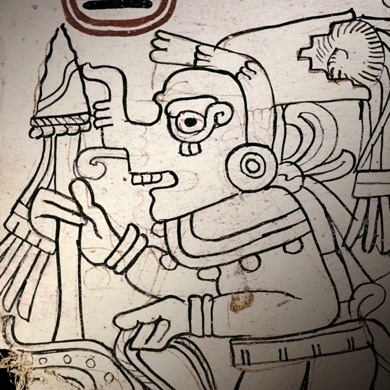Scientists have been arguing over the authenticity of an ancient document called the Grolier Codex for 50 years. A new analysis published in a special section of the journal Maya Archaeology has concluded that the codex is indeed genuine, making it the oldest surviving manuscript from the pre-Colombian era.
The Grolier Codex is the oldest known manuscript in ancient America. (Image: Justin Kerr)
Perhaps you’re not familiar with the Grolier Codex. It’s the surviving pages of a 20-page book, made of stucco-coated bark paper folded into an accordion shape. The pages are painted with typical Maya iconography — gods, warriors, slaves, and hieroglyphs, for instance — and include a calendar charting the movement of the planet Venus.
Legend has it that looters ransacking a cave in Mexico came across the badly damaged pages in the 1960s, along with a turquoise mask, a sacrificial knife, and some blank pieces of fig-bark paper. That’s according to a Mexican collector named Josue Saenz, who claimed he was contacted by the looters and taken by plane to a remote airstrip to collect the items — although at least one archaeologist, Donna Yates, has called this account “fantastical”.
Saenz’s questionable account and subsequent actions cast doubt on the authenticity of the fragments from the start, even though the other artifacts have since been shown to be genuine. Scientists tested the codex in 2007, but couldn’t decisively settle the matter of its authenticity, partly because while many of the materials used were pre-Colombian, some of the wear and tear in the pages seemed artificial.
It was possible a gifted forger may have used materials from the right period to throw off archaeologists. And radiocarbon dating revealed the blank pages of bark paper found with the codex pegged them to around 1230 AD.

A detail from the Grolier Codex. (Image: Justin Kerr)
“It became a kind of dogma that this was a fake,” co-author Stephen Houston of Brown University said in a statement. “We decided to return and look at it very carefully, to check criticisms one at a time. Now we are issuing a definitive facsimile of the book. There can’t be the slightest doubt that the Grolier is genuine.”
Along with Harvard University’s Michael Coe, and Mary Miller and Karl Taube of the University of California, Riverside, Houston reviewed all the known research on the codex.
That included assessing the manuscript’s origins, the carbon dating results, the various deities depicted, how the bark paper was made, the Maya blue pigments, and thin red sketch lines underneath the paintings, among other aspects. The team concluded that a forger in the 1960s simply could not have known all the details required to create such a forgery. Many of the deities shown in the codex hadn’t even been discovered then, for example, and scientists didn’t successfully make Maya blue in the lab until the 1980s.
There are three other known (authenticated) ancient Maya manuscripts, known as the Dresden, Madrid, and Paris Codices, in addition to the Grolier Codex. There are variations among them, but all include astronomical calendars tracking the movements of heavenly heavenly bodies. And radiocarbon dating shows the Grolier predates the other three.
“A reasoned weighing of evidence leaves only one possible conclusion,” the authors wrote. “Four intact Mayan codices survive from the Precolumbian period, and one of them is the Grolier.”
